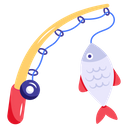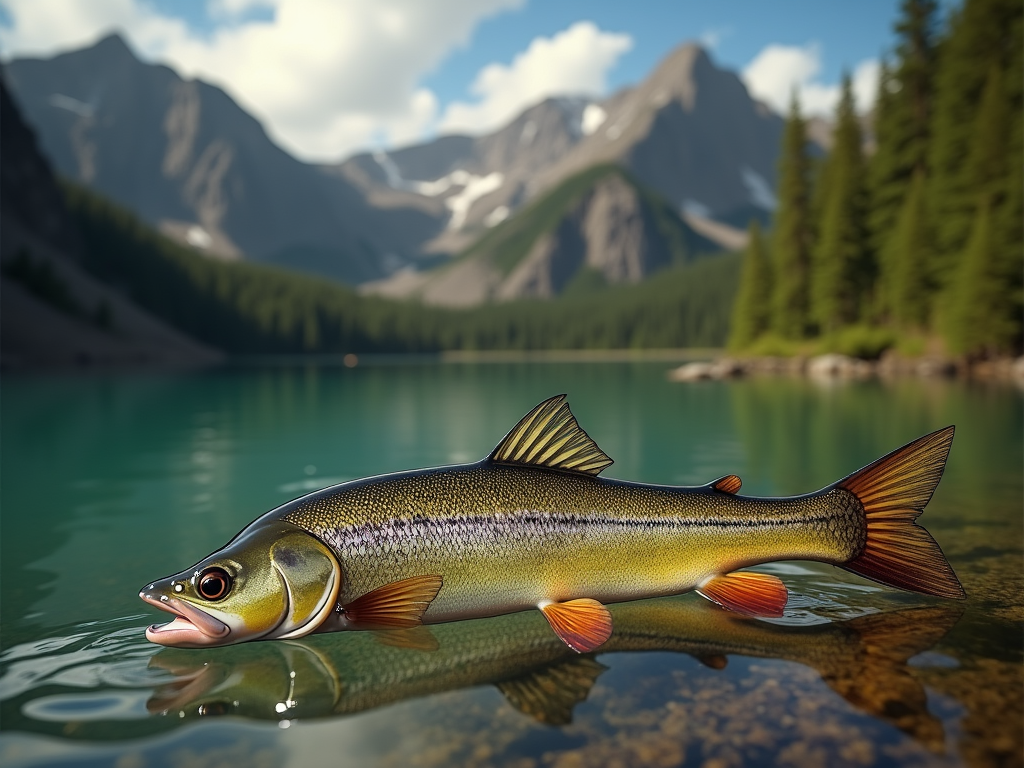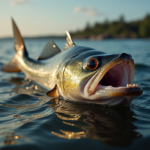Fishing is not just a sport; it’s an adventure filled with tranquility and excitement, especially for those starting. As a beginner, understanding the essential fishing tackle is vital for a successful fishing trip. From the fishing rod to the lures, every piece of gear plays a crucial role in ensuring that your experience on the water is enjoyable and fruitful. This complete guide is designed to demystify the world of fishing tackle basics, providing you with insights into selecting the right rod and reel, understanding various fishing lines, and choosing effective lures that can significantly enhance your chances of catching fish.
Navigating through the plethora of options might feel overwhelming at first, but with the right guidance, you can build a solid foundation of knowledge that will benefit you throughout your fishing journey. Learn to organize your gear effectively with tackle boxes, equip yourself with essential safety gear and accessories, and discover the best places to purchase your fishing tackle. By the end of this guide, you’ll be well-prepared and confident for your first fishing trip, ready to cast your line with the right tools in hand and an eagerness to explore the great outdoors.
Introduction to Fishing Tackle Basics
Fishing tackle is the collective term for the equipment used by anglers to catch fish. Understanding the different components of fishing tackle is crucial, especially for beginners, as it significantly affects the success of their fishing experience. Essential fishing gear not only helps to facilitate the actual catching of fish but also plays a vital role in the comfort and enjoyment of the activity. For those just starting, navigating the various types of fishing tackle can seem daunting, but a solid grasp of the basics can lead to more productive trips and a deeper appreciation for the sport.
Essential Fishing Gear for Beginners
Key Components of Fishing Tackle
- Rod: The fishing rod is a long, flexible pole that aids in casting and reeling in fish. Selecting the right rod is essential for balancing strength and flexibility.
- Reel: A reel is attached to the rod and is used to wind and store the fishing line. There are various types of reels, including spinning, baitcasting, and fly fishing reels.
- Line: Fishing line connects the lure or bait to the reel. The choice of line—monofilament, fluorocarbon, or braided—will depend on the type of fish being targeted and the fishing conditions.
- Hooks: Hooks come in various sizes and shapes, designed to secure the fish once it bites. Understanding the type of hook is pivotal for different fishing methods.
- Lures and Baits: These are essential for attracting fish. Lures mimic the movement of prey, while bait consists of real or artificial items used to entice fish.
Importance for Beginners
- Understanding Gear: Familiarity with fishing tackle helps beginners make informed decisions when purchasing equipment, ensuring they choose the right essential fishing gear for their needs.
- Enhanced Fishing Experience: Properly selected fishing tackle for beginners increases the likelihood of fishing success, making trips more enjoyable and less frustrating.
- Skill Development: Gaining knowledge about fishing tackle allows beginners to develop essential skills and techniques that will serve them throughout their fishing journey.
This foundational knowledge equips novice anglers with the confidence to explore the vast world of fishing, ensuring they are well-prepared for their outdoor adventures.
Understanding Different Types of Fishing Tackle
Types of Fishing Tackle Components
Fishing Rods
Fishing rods are essential tools for anglers that come in various lengths, materials, and action types. The primary categories include:
- Spinning Rods: Lightweight and versatile, suitable for beginners and advanced anglers.
- Baitcasting Rods: Designed for precision casting and handling larger fish.
- Fly Rods: Specialized for fly fishing, with unique features to accommodate fly lines.
Fishing Reels
Fishing reels are crucial in the casting and retrieval process, and they vary based on the angler’s needs. The main types of fishing reels include:
- Spinning Reels: User-friendly and ideal for light tackle fishing.
- Baitcasting Reels: Provide greater control and accuracy, suitable for targeting larger species.
- Fly Reels: Specifically designed for use with fly rods, they allow for quick line retrieval and manipulation.
Fishing Lines and Lures
Fishing Lines
Selecting the right fishing line is vital for successfully landing fish. The common types include:
- Monofilament Line: Flexible and user-friendly, ideal for novices.
- Braid Line: Offers high strength and thin diameter, excellent for deep-water fishing.
- Fluorocarbon Line: Nearly invisible underwater, perfect for wary fish.
Fishing Lures
Lures imitate prey to attract fish, and they come in several styles:
- Soft Plastics: Versatile and effective; they mimic various bait types.
- Crankbaits: Designed to mimic swimming action, suitable for active species.
- Jigs: Versatile and effective in various conditions; great for bottom fishing.
Summary Table of Fishing Tackle Types
| Tackle Component | Types |
|---|---|
| Rods | Spinning, Baitcasting, Fly |
| Reels | Spinning, Baitcasting, Fly |
| Lines | Monofilament, Braid, Fluorocarbon |
| Lures | Soft Plastics, Crankbaits, Jigs |
Understanding the various types of fishing tackle and their specific applications enhances your fishing experience and helps in selecting the right fishing gear 101 for your adventures.
Selecting the Right Fishing Rod for Beginners
Factors to Consider When Choosing a Fishing Rod
Choosing the best fishing rods for beginners involves understanding key factors that will affect your fishing experience. Primarily, consider the length of the rod, which typically ranges from 5 to 9 feet. A shorter rod offers better control for close-quarters fishing, ideal for small ponds or tight spaces, whereas a longer rod can help cast further distances, perfect for larger bodies of water.
Recommended Lengths by Fishing Type
| Fishing Type | Recommended Rod Length |
|---|---|
| River or Stream | 5 to 7 feet |
| Lake Fishing | 6 to 8 feet |
| Surf Fishing | 8 to 10 feet |
Rod Action: Understanding Flexibility
Another crucial element in selecting the best fishing rods for beginners is understanding action. Rod action refers to how much and where the rod bends when pressure is applied. Generally categorized into three main types: fast, medium, and slow.
- Fast Action Rods: Bend mostly at the tip, providing sensitivity and quick hook-setting—ideal for experienced anglers but can be challenging for beginners.
- Medium Action Rods: Offer a balance between sensitivity and flexibility, making them suitable for a variety of fishing techniques and perfect for novices.
- Slow Action Rods: Bend more throughout the length of the rod, providing a softer feel and making it easier to cast lightweight lures.
Material Matters: Choosing the Right Composition
The material of the fishing rod also plays a vital role. Rods are mainly made from graphite or fiberglass:
- Graphite Rods: Lightweight and sensitive, making them a good choice for quick strikes and finesse fishing.
- Fiberglass Rods: More durable and typically less expensive, these rods are excellent for beginners who may be hard on their gear.
By evaluating these factors—length, action, and material—novice anglers can make informed decisions, ensuring they choose the best fishing rods for beginners that suit their fishing style and preferences.
Choosing the Perfect Fishing Reel
Understanding Fishing Reel Types
When it comes to fishing reel types, there are three primary categories to consider: spinning reels, baitcasting reels, and spincast reels. Each type serves different fishing techniques and preferences, making it essential to choose wisely based on your fishing style.
Spinning Reels
- Best For: Beginners and versatile fishing applications.
- Design Features:
- Open-faced design allows for quick line retrieval.
- Lightweight and easy to handle.
- Excellent for casting lighter baits or lures.
- Advantages:
- Minimal backlash issues.
- Can handle a variety of fishing techniques from freshwater to saltwater.
Baitcasting Reels
- Best For: Experienced anglers looking for precision.
- Design Features:
- Closed design with a rotating spool.
- Offers better control for casting heavier lures and baits.
- Advantages:
- Greater accuracy in casting.
- Strong drag systems suitable for larger fish.
- Considerations:
- Requires skill to avoid backlash.
- Not ideal for lighter lures.
Spincast Reels
- Best For: Casual fishing and kids.
- Design Features:
- Closed-face design with a push-button release.
- Enclosed mechanics protect against dirt and debris.
- Advantages:
- Easy to use, making it suitable for beginners.
- Minimal tangles and easy line management.
- Limitations:
- Not as versatile as spinning or baitcasting reels.
- Limited casting distance and accuracy.
Choosing the Right Fishing Reel
When selecting the right fishing reel, consider the following factors:
- Fishing Environment: Freshwater vs. saltwater.
- Target Fish Species: The size and weight of the fish you aim to catch.
- Angling Experience: Your skill level will significantly impact your choice.
| Reel Type | Best For | Key Features | Skill Level |
|---|---|---|---|
| Spinning Reel | Versatility | Open-faced design, lightweight | Beginner |
| Baitcasting Reel | Precision | Closed design, rotating spool | Intermediate to Advanced |
| Spincast Reel | Casual Fishing | Closed-face, easy push-button | Beginner |
By understanding the various fishing reel types and how they align with your personal preferences and fishing goals, you can make a well-informed choice that enhances your fishing experience.
Fishing Lines: The Unsung Heroes
Varieties of Fishing Lines
Monofilament Fishing Lines
-
Characteristics:
- Made from a single strand of nylon.
- Offers stretch and flexibility, making it forgiving during strikes.
- Available in various colors and line diameters.
- Generally less visible in water compared to other types.
-
Best Uses:
- Ideal for beginners due to its ease of use and affordability.
- Suitable for freshwater fishing, particularly for species like bass and trout.
- Often recommended for topwater lures due to its buoyancy.
Fluorocarbon Fishing Lines
-
Characteristics:
- Composed of polyvinylidene fluoride (PVDF).
- Nearly invisible underwater, providing stealth in clear water.
- Offers a low stretch, enhancing sensitivity and hook-setting power.
- Resistant to UV light and abrasion.
-
Best Uses:
- Excellent for finicky fish in clear environments, such as trout and walleye.
- Perfect for leaders, where invisibility is crucial.
- Effective in both freshwater and saltwater conditions.
Braided Fishing Lines
-
Characteristics:
- Made from multiple strands of synthetic fibers woven together.
- Extremely strong for its diameter, enabling higher line tests.
- Minimal stretch, providing maximum sensitivity and control.
- Typically has a thicker diameter than monofilament or fluorocarbon for the same strength.
-
Best Uses:
- Ideal for heavy cover fishing or saltwater applications, where strength is paramount.
- Perfect for techniques requiring strong hook sets, such as jigging or trolling.
- Works well in environments with thick vegetation or obstacles, like weed beds.
Selecting the Best Fishing Line for Different Environments
| Environment | Recommended Line Type | Key Features |
|---|---|---|
| Freshwater (clear) | Fluorocarbon | Low visibility, abrasion-resistant |
| Freshwater (murky) | Monofilament | Good stretch, forgiving during strikes |
| Saltwater | Braided | High strength, minimal stretch |
| Heavy Cover | Braided | Strong, ideal for snaggy areas |
| Light Tackle | Monofilament | Affordable, versatile for various lures |
| Finicky Fish | Fluorocarbon | Stealthy, enhances sensitivity |
- Tips for Choosing:
- Consider the type of fish and their behaviors in different water conditions.
- Take into account the kind of fishing techniques you’ll be using, such as trolling or fly fishing.
- Match the line strength to your rod and reel setup for optimal performance.
Essential Fishing Lures: What Beginners Should Know
Types of Fishing Lures
1. Jigs
- Description: Weighted heads with hooks, often dressed with feathers or soft plastic.
- How They Work: Retrieve by lifting and dropping, mimicking the motion of a baitfish.
- Must-Have for Beginners: Versatile for various species, effective in different water conditions.
2. Spinnerbaits
- Description: Wire frames with one or more spinning blades and a skirt.
- How They Work: Blades create vibrations and flash, attracting fish in murky water.
- Must-Have for Beginners: Great for catching bass and other predatory fish.
3. Crankbaits
- Description: Hard-bodied lures with a built-in action.
- How They Work: Dive to specific depths when retrieved, mimicking baitfish.
- Must-Have for Beginners: Ideal for covering large areas quickly.
4. Soft Plastics
- Description: Flexible lures available in various shapes and sizes.
- How They Work: Can be rigged in multiple ways (Texas, Carolina), sinking and swaying like natural prey.
- Must-Have for Beginners: Highly effective for freshwater and saltwater fishing.
Key Insights for Using Beginner Fishing Lures
- Choosing the Right Color: Bright colors work well in murky waters, while more natural hues should be chosen for clearer conditions.
- Seasonal Considerations: Certain lures perform better in specific seasons; for instance, jigs may be more successful in colder months.
- Water Depth: Select lures that correspond to the depths you plan to fish; deeper diving crankbaits are ideal for deeper waters.
Quick Reference Table of Beginner Fishing Lures
| Type | Key Features | Target Species |
|---|---|---|
| Jigs | Versatile, mimics baitfish | Bass, Walleye |
| Spinnerbaits | Creates vibrations and flash | Bass, Pike |
| Crankbaits | Depth specific, hard-bodied | Bass, Trout |
| Soft Plastics | Flexible, rigged in multiple ways | Various freshwater species |
- Important Note: Always maintain a variety of beginner fishing lures in your tackle box to adapt to changing conditions and fish behavior.
Fishing Tackle Boxes: Organizing Your Gear
Importance of a Tackle Box
A fishing tackle box is an essential piece of equipment for any angler, providing a central location to organize, store, and protect your fishing gear. It helps prevent loss and damage to your lures, reels, lines, and other tackle, ensuring quick access to what you need while out on the water. Proper organization can also save time and enhance your fishing experience, allowing you to focus on your catch rather than rummaging through messy gear.
Types of Tackle Boxes
There are several types of fishing tackle boxes available, catering to different fishing styles and preferences. Here are a few popular options:
- Hard-sided tackle boxes: These provide maximum protection and often have multiple compartments for small items. Ideal for boat fishing.
- Soft-sided tackle bags: Lightweight and portable, these bags have adjustable compartments and are perfect for bank fishing or hiking.
- Tackle trays or boxes: Stackable and compact, these are great for organizing lures and small components and are perfect for portable use.
- Bait buckets: Essential for live bait, these can double as a tackle box with designated compartments for lures.
Fishing Tackle Box Tips for Organization
To optimize the effectiveness of your fishing tackle box, consider the following organizing tips:
- Categorize your gear: Organize tackle by type (lures, hooks, weights) or by species for easy access.
- Use compartments and dividers: Make use of removable trays or adjustable dividers to maximize space and minimize clutter.
- Label items: Clearly label sections or boxes within your tackle box to quickly find the gear you need when time is of the essence.
- Regularly assess and restock: After each fishing trip, take the time to assess your tackle box and restock or reorganize as necessary.
Employing these fishing tackle box tips can help streamline your fishing experience, keeping everything organized and easily accessible whether you are a beginner or a seasoned angler.
Safety Gear and Accessories Every Fisherman Needs
Essential Fishing Safety Gear
-
Life Jackets
- A U.S. Coast Guard-approved life jacket is crucial for any fishing trip, especially in open waters.
- Ensure it fits properly and is comfortable to wear for extended periods. Consider options with extra storage for small gear.
-
First-Aid Kits
- A well-stocked first-aid kit is indispensable for handling minor injuries. Essential items include:
- Adhesive bandages
- Antiseptic wipes
- Pain relievers
- Burn cream
- Consider waterproof kits to protect contents from the elements.
Sun Protection Accessories
-
Sunscreen
- Use a broad-spectrum sunscreen with at least SPF 30 to protect against harmful UV rays. Reapply regularly, especially after swimming or sweating.
-
Wide-Brimmed Hats
- A wide-brimmed hat provides essential shade, reducing exposure to the sun while keeping you cool.
-
Polarized Sunglasses
- Invest in polarized sunglasses to protect your eyes from UV rays and reduce glare on the water’s surface.
Additional Safety Considerations
-
Emergency Whistle
- A whistle can be an effective communication tool if you find yourself in distress, especially in noisy environments.
-
Weather Radio
- A portable weather radio helps you stay informed about changing weather conditions, ensuring you can respond to threats early.
-
Fishing Safety Gear Checklist



